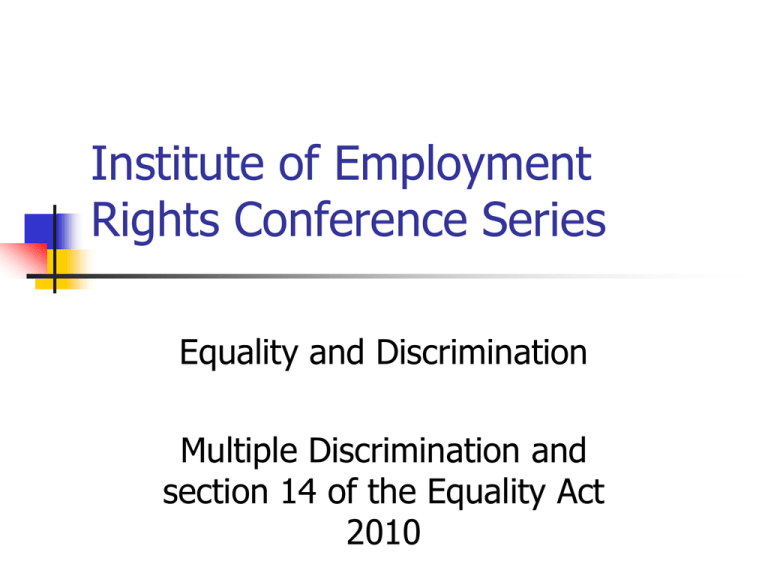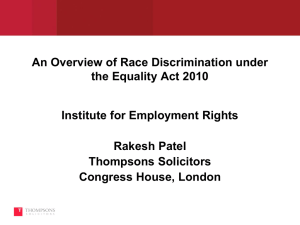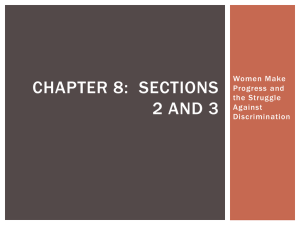
Institute of Employment
Rights Conference Series
Equality and Discrimination
Multiple Discrimination and
section 14 of the Equality Act
2010
Dual discrimination
Equality Act 2010
Section 14: combined discrimination:
dual characteristics
Direct discrimination to treat someone
less favourably because of a
combination of two relevant protected
characteristics
Not now coming into force
Multiple discrimination (1)
“standard” multiple discrimination
Ie consecutive incidents
A person is discriminated against
because of their race on one occasion
And because of their disability on
another
Eg Al Jumard v Clywd Leisure Limited
2008 IRLR 345, EAT
Multiple discrimination (2)
Additive discrimination
A person is discriminated against
because of both her sex and her sexual
orientation
Eg Where a lesbian experiences
homophobic and sexist bullying and
harassment
Multiple discrimination (3)
Intersectional discrimination
where a person is discriminated against
because of different characteristics in
combination
Eg a driver does not allow a Muslim
man onto a bus because he is
stereotyped as a potential terrorist
But would allow a Muslim woman or
Christian man
Protection for multiple
discrimination
There is no difficulty with standard or
additive discrimination where the law
provides adequate protection
It is with intersectional discrimination
that there has been understood to be a
difficulty
It is this form of discrimination which
section 14 seeks to address
Limits of section 14
Only combination of 2/7 protected
characteristics but could be more
Only for direct discrimination
But examples of indirect discrimination
Keeling v Public Information Pillars, ET
Azmi v Kirklees MBC 2007 IRLR 484
And harassment
Eg Richmond Pharmacology v Dhaliwal
2009 WLR (D) 54
Gap in protection?
So if section 14 was introduced to deal
with a particular problem, and is now
not coming into force, does that mean
that there is a gap in protection?
Can intersectional discrimination be
challenged given the decision of the
government not to bring it into force?
need to ask: what gap did it seek to
fill?
Origins of the gap
Tribunal must find primary facts in
respect of each characteristic
Bahl v Law Society 2004 IRLR 799, CA
“it was necessary for the ET to find the
primary facts in relation to each type of
discrimination..then to explain why it was
making the inference”
Network Rail v Griffiths-Henry 2006
IRLR 865, EAT
Burden of proof
Direct evidence of discrimination is rare
claimant to show prima facie case of
both sex and race discrimination
Inferences will be drawn from primary
facts
Employer to provide explanation for the
treatment eg by pointing to comparators
Treatment for more
than one reason
The protected characteristic need not
be the sole or even the principal reason
for the treatment; it is sufficient that it
had a significant influence on the
outcome
Owen & Briggs v James 1982 IRLR 502, CA
O’Donoghue v Redcar & Cleveland Borough
Council 2001 IRLR 615, CA
Nagarajan v London Regional Transport 1999
IRLR 572, CA
O’Reilly v BBC
“the prescribed reason need not be the sole
reason, or even the principal reason, why a
person suffers detrimental treatment. Part of
the reason that a woman over 40 is precluded
from applying for the job is the fact that she is
a woman. Another part of the reason is that she
is over 40. Both of them are significant
elements of the reason that she suffers the
detriment. In such circumstances we consider it
is clear that the woman is subject to both sex
and age discrimination”.
The rise of the comparator
A comparison is required in order to
show less favourable treatment
This came to mean that a claimant was
required to point to an actual
comparator
Or to carefully construct a “hypothetical
comparator”
As a legal hurdle rather than of
evidential assistance
And fall...The focus on the
reason why
Shamoon v RUC 2003 IRLR 285, HL
“This analysis seems to me to point to the
conclusion that employment tribunals may
sometimes be able to avoid arid and
confusing disputes about the identification
of the appropriate comparator by
concentrating primarily on why the
claimant was treated as she was. Was it on
the proscribed ground which is the
foundation of the application?”
Further endorsement from the
Supreme Court
Hewage v Grampian Health Board 2012
IRLR 870, SC
“The question whether the situations were
comparable is, however, a question of fact
and degree”
“Burden of proof provisions...will require
careful attention when there is room for
doubt...but they have nothing to offer
where the tribunal is in a position to make
positive findings on the evidence”
What about indirect
discrimination?
MOD v Debique 2010 IRLR 471, EAT
“The nature of discrimination is such that it
cannot always be sensibly compartmentalised
into discrete categories. Whilst some
complainants will raise issues relating only to one
or other of the prohibited grounds, attempts to
view others as raising only one form of
discrimination for consideration will result in an
inadequate understanding and assessment of the
complainant’s true disadvantage. Discrimination
is often a multi-faceted experience.’
What about harassment?
“the prohibition of harassment is not
expressly comparative, and conduct involving
a combination of protected characteristics is
more likely to satisfy the standard of being
“related to” each characteristic, even when
considered separately. Moreover, because the
associative definition of harassment used in
the Bill eliminates any element of causation,”
(Baroness Royall of Blaisdon HL
Hansard 13 Jan 2010, col 546-7)
Support from European law?
Directives cover discrimination based on a
single characteristic
But see Race Directive Preamble para 14
‘In implementing the principle of equal
treatment irrespective of racial or ethnic
origin, the Community should … aim to
eliminate inequalities, and to promote
equality between men and women,
especially since women are often the
victims of multiple discrimination.’










